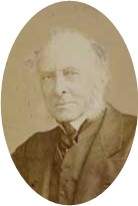Moore collaborated with many geologists over the years, both amateur and professional, and was well known within the geological community. From his correspondence it is evident that he was frequently sharing his knowledge and expertise with others, often sending specimens from his collection to aid in various studies or describing and identifying fossils sent to him.
One such collaboration was with Thomas Davidson, a Brachiopod expert, with whom Moore supplied specimens and descriptions of Brachiopods in order to aid Davidson in compiling a monograph on the subject, complete with illustrations.
 |
Illustrations of Brachiopods drawn by Thomas Davidson from specimens supplied by Moore
[LDGSL/802/1/DAVIDSON/]
|
Moore also aided Professor Richard Owen, the English comparative anatomist and palaeontologist, with his palaeontological research. When, in 1858, Moore discovered fossils in a Triassic deposit near Frome, he sent several specimens to Owen to examine. Amongst these were Microlestes teeth and some vertebrae.
Owen would later go on to publish papers discussing Moore’s finds and further use this evidence in his own monograph on palaeontology. The correspondence between Moore and Owen was not entirely focused on collaboration, however, as some of Owen’s letters in the Geological Society Archive include criticisms of fellow geologists. Moore’s friendship with Owen continued throughout both of their careers with Moore visiting Owen as late as 1879.

|
Owen, R. On some small Fossil Vertebræ
from near Frome, Somersetshire,
Quarterly Journal of the Geological Society (1860) 16 pp.492-497
|
While it appears that Moore was happy to share his geological and palaeontological knowledge, he had a strained relationship with some professional geologists whom he believed took advantage of his expertise without proper recognition.
In his biography, Reverend Henry Hoyte Winwood remarks that Moore looked upon professional geologists with “jealous suspicion” after the geologists on the Geological Survey “drew upon his detailed knowledge of local geology without acknowledgement”. In addition to this, Moore was often beaten to print by others in the field who were able to publish the same findings first, as he was a slow writer with a desire to have accurate illustrations and descriptions.
One very public disagreement that found its way onto the pages of Geological Magazine was between Moore and geologist Dr Thomas Wright of Cheltenham. Moore explained in a letter to Geological Magazine in 1875 that Wright had misidentified a specimen as being a cirripede when it was in fact a crinoid. Moore brought the mistake to Wright’s attention, after which he published a note on the specimen without acknowledging Moore’s key involvement.
To add to the insult, Wright had wrongly identified the genus and presented the specimen as being a new discovery, when Moore had previously shown Wright examples from his own personal collection. This feud continued with a similarly vitriolic reply from Wright.
 |
|
“The December Number of your Magazine contains a letter from Mr. Chas. Moore, of Bath, purporting to be a notice of ‘the genera Plicatocrinus, Cotylederma, and Solanocrinus,’ of which he tells us next to nothing, but attempts to make it appear that I made an erroneous diagnosis of the Cotylederm I described in the October Number of the Magazine, and gives an inaccurate account of private conversations which ought not to have been published. […] I consider it very unfair on his part to state that I had made an incorrect diagnosis of ‘a group of fossils, on which I had been so long at work,’ merely to show that the correction of the error was due to himself.” Wright, T. (1876) 'On the Cotyledermidae', Geological Magazine, 2(3) pp.94-95
|
Whilst some of Moore's professional relationships may have been tumultuous, the resounding view of Moore was that he was hardworking, dedicated and added much to the field of geology.
<< Back to main page
Bibliography >>